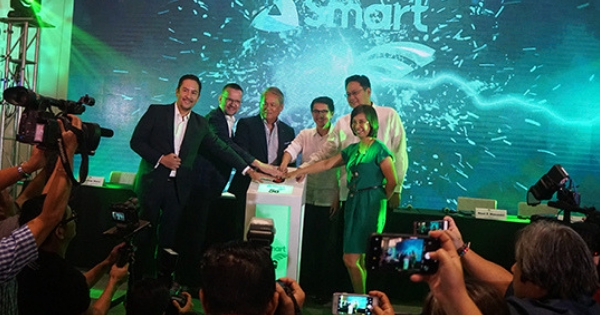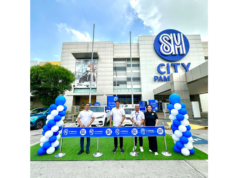(SWITCH ON. Backdropped by a splash of company colors, Smart Enterprise Group senior VP Jovy Hernandez, chief technology and information advisor of PLDT Inc. Joachim Horn, PLDT chief revenue officer Eric Alberto, BCDA president-CEO Vince Dizon, CDC president Noel Manankil and CDC VP for business development Eva Tejada jointly launch the country’s first 5G network in Clark.)
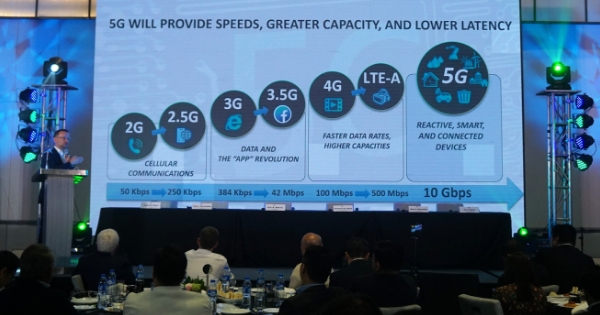
(PLDT technology and information advisor Joachim Horn presents 5G evolution.)
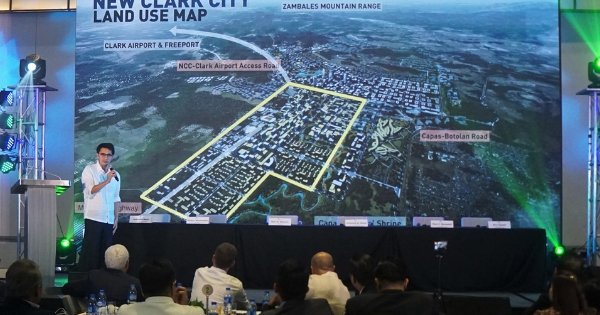
(BCDA’s Vince Dizon gives update on New Clark City developments.)
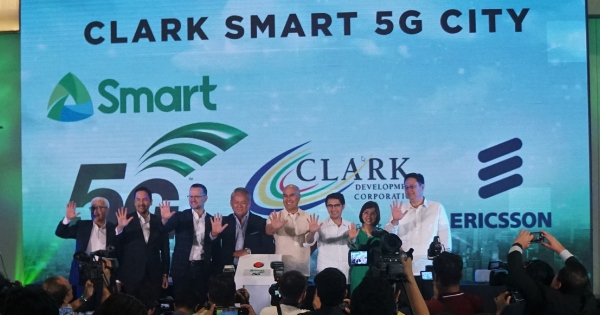
(Mabalacat City Mayor Cris Garbo joins PLDT-Smart, BCDA and CDC top executives in giving a high-5 at the launch. All photos by Bong Lacson)
CLARK FREEPORT – The first 5G cell site in the country was fired up on Monday by leading telecom company and digital solutions provider PLDT and its wireless subsidiary Smart Communications Inc. (Smart) with Clark Development Corp. (CDC) and its parent company the Bases Conversion and Development Authority (BCDA).
Past noon time, officials of the telecom company led by its senior revenue officer Ernesto “Eric” R. Alberto and its technology partner Ericsson as well as CDC president and CEO Noel F. Manankil and BCDA president/CEO Vivencio “Vince” Dizon, and the local government of Mabalacat City led by Mayor Cris Garbo switched on the 5G cell site in a ceremony held at the Marriott Hotel here just days before the bidding for the third telecommunications player in the country.
Doing the welcome remarks was senior vice president and head of enterprise for PLDT and Smart Juan Victor “Jovy” Hernandez who underscored the relevance of speed in data processing for today’s technology.
He detailed how technology progressed from 2G and 2.5G for cellular communications decades ago to 3G and 3.5G for data and the eventual app revolution years ago to the recent 4G and LTE-A technology for faster data rates and higher capacity and to the present 5G technology for reactive, smart and connected devices.
“By piloting 5G in Clark, we are making this zone even more attractive to foreign investors,” said Hernandez. “Through this pilot, we are putting the possibilities of 5G closer to industries, businesses and enterprises operating in the city.”
Ericsson’s Joachim Horn and Nunzio Mirtillo made a technology presentation on the 5G project.
Horn showed how Ericsson technology can showcase possible use for 5G in an exhibit that featured Ericsson’s Robotic Arm, Balancing Robot, Connected Mangroves and Connected Fleet technologies.
Also, in line with the program, PLDT and Smart are ramping-up the roll-out of LTE in key areas in this freeport and equipping all of them with 5G facilities in the coming months.
On the other hand, the roadmap for Clark was presented by Dizon who bannered the government’s “Build, Build, Build Program” by presenting ongoing four big-ticket projects beginning with the new terminal of the Clark airport, Manila-Clark rail project, New Clark City, and the Subic-Clark rail project.
Dizon also thanked PLDT for making this freeport its first deployment of the 5G technology.
“We are glad that Clark was chosen to serve as the location for the very fi rst 5G wireless platform in the Philippines. This, we believe, will not only be of benefi t to Clark locators but also the many industries, various businesses and communities in the country as well,” said CDC’s Manankil.
“This undertaking forms part of the vision to help create communities that are smart, technology focused, something that would help keep our country in the right cadence into the future,” he added.
For his part, PLDT and Smart chairman/ CEO Manuel V. Pangilinan said in a statement: “We are happy to be working with CDC in building the city of the future, equipped with smart services and powered by 5G infrastructure right here in Pampanga. This will benefit not only Clark but the country as well by demonstrating that we are in step with the rest of the world in adopting advanced intelligent technologies.”
Exciting possibilities
With its capability to deliver extremely high speeds coupled with low latency, 5G opens up exciting possibilities for Internet of Things (IoT) applications for Filipinos, as well as smart applications for the transport sector, traffic management, manufacturing, airport and mall operations, logistics and warehousing, retail, customer support, and smart homes, among others.
“Through this pilot deployment, we will be able to test 5G’s capabilities using a live network and develop solutions that will serve the future needs of industries and government, such as autonomous vehicles, connected fleets, and smart buildings and factories,” said Alberto.
Armed with both fixed and wireless infrastructure powered by the country’s most extensive fiber network now at over 221,000 kilometers, PLDT and Smart are best positioned to deploy 5G in the country.
“To deliver 5G services to its customers in the future, Smart is upgrading its network’s Core and Transport elements. This includes upgrading to fiber the backhaul connecting the network’s cell sites around the country and deploying 5G-ready equipment in the ongoing LTE rollout,” according to Mario G. Tamayo, PLDT-Smart senior vice president for network planning and engineering.
“As we continue to roll-out LTE, LTE-Advanced and carrier aggregation technology nationwide, we are also making sure that these are already future-proof and 5G-capable,” Tamayo added.
Under its current network upgrade program, Smart is installing 5G-compatible radio equipment across its network, which now has over 2,000 5G-ready sites.
Apart from ultra-high speeds, the key features of 5G include enhanced mobile broadband services, massive machine type communications, and ultra-reliable and low latency communications.
Earlier in August, Smart and Ericsson signed an MoU to deploy the country’s first 5G pilot network by the first half of 2019. Under the MoU, the 5G network will be first deployed in Luzon, the country’s largest and most populous island where about a third of the population work and live.
The 3GPP compliant 5G Trial System that will be deployed in Smart includes Ericsson 5G RAN, Core and Transport solutions. The 5G pilot deployment will allow Smart to explore industry partnership engagements, collaborate with schools and universities, and further develop competence in 5G.
Testing 5G since 2016
Smart has been testing 5G since 2016, when it achieved speeds of 2.5 Gigabits per second (Gbps) using 100 MHz with latency of just 1 millisecond over a ‘live’ network—the first in the Philippines. As part of its 5G preparations, Smart also launched in June its 5G Technolab, the company’s flagship facility for the research and development, standardization, and testing of 5G, which is designed to be a sustainable environment for innovative services.
Parent company PLDT has committed historic levels of resources for network transformation. For 2018, PLDT capex is expected to reach P58 billion, which includes allocations for the aggressive roll-out of its fiber broadband service, which also supports the stepped-up deployment of the mobile network by providing high-capacity links for cellular base stations.
A memorandum of understanding (MoU) was signed by PLDT and Smart, together with technology partner Ericsson and the CDC preceding the launching for the country’s first smart 5G deployment in this freeport.


